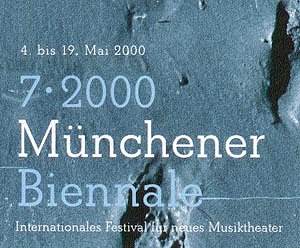
André, Asmus, Cox, Czernowin, Mahnkopf, Riedl, Schurig, Schneid, Smolka - those are some of the less familiar names of composers who were featured at Munich Biennale. This is the seventh of the Munich festivals. They aim to explore extreme experiments in contemporary music, and for the first in the new century there was a strong theatrical component. The Biennale is promoted by the City of Munich, together with other organisations and a thriving Friends group. Its artistic director is Peter Ruzicka, who conducted the Munich Philharmonic Orchestra in Varese, Henze and Czernowin before we arrived for our week. This year his main theme has been 'to create theatre from music, say goodbye to words and plot, and reinvent drama'. This notion was explored in two music-theatre pieces which we saw and heard.
Unlike Strasbourg or Huddersfield, the Munich festival is a leisurely affair spread over two weeks, with effectively only one event most days (plus discussion sessions in German, which we did not attend). So we complemented this serious diet with three repertory performances at the State Opera, and also took in another wordless music-theatre event, the Irish show Riverdance, which attracted 3000 people to come indoors from the spectacular Olympic Park on a sunny Saturday afternoon. Reviews of those to follow in due course.
Holidaying in Munich
Munich is a splendid city for a holiday break, with more to see than is possible in a week. It feels very open, with tree lined wide streets, lush greenery close to the city centre, and many wonderful parks with lakes and rushing rivers. There is pleasant eating out outdoors and in, with good value cafes, restaurants and beer halls everywhere. Great museums, palaces and churches, most of them completely rebuilt after the bombing devastation, which we were told had destroyed 98% of the buildings, so that they had contemplated rebuilding a new Munich some fifty miles away!
The atmosphere was friendly and helpful (as we had found in Stuttgart too) and the excellent cheap integrated transport is easy to use - their three days 'partner ticket' a remarkable bargain. Being located on a plain, not far from the Alps, it is mainly flat, and pedestrians mix easily with bicycles and roller-blades which are ubiquitous; a cycle tour through city streets and the vast Englischer Garten was a particular pleasure. The UK exchange rate makes Munich a very desirable holiday destination.
Music Theatre
The two commissioned Music Theatre pieces which we saw ostensibly omitted words, whether spoken or sung, and left interpretation very much to individuals in the audience; we will be commenting upon that approach.
Pnim...Inner States by Chaya Chernovin
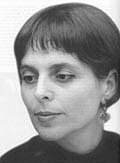 In her new music-theatre piece at the Carl-Orff-Saal of the Gasteig
Cultural Centre Chaya Chernovin (b. 1957), an Israeli composer now
living in California, aims to give auditory and visual expression to the
emotional life of two characters, without recourse to a linear narrative
through language.
In her new music-theatre piece at the Carl-Orff-Saal of the Gasteig
Cultural Centre Chaya Chernovin (b. 1957), an Israeli composer now
living in California, aims to give auditory and visual expression to the
emotional life of two characters, without recourse to a linear narrative
through language.
The starting point for this work was a novel by David Grossman.
Pnima…Inner States brings alive the predicament of a withdrawn
old man, a holocaust survivor newly released from a mental hospital, enacted
very effectively by Richard Beek. He is still unable to break out of the
strait-jacket of fearful memories. His young grandson, played with great
self-assurance by Elias Maurides, appears on stage, at first playful and
normal, and attempts to make contact with his distressed grandfather. But
the boy only seems to succeed for a flickering moment and, he too, becomes
withdrawn and
 pinned
down by unseen forces. A direct causal link between the emotional fates of
these two beings is perhaps not sufficiently set out through visual or sound
metaphors and can only be deduced by going beyond the material presented.
However, under the direction of Claus Guth, and with very effective set designs
by Christian Schmidt, Pnima…Inner States does succeed in creating
a visual picture and externalising the inner states of the two characters.
pinned
down by unseen forces. A direct causal link between the emotional fates of
these two beings is perhaps not sufficiently set out through visual or sound
metaphors and can only be deduced by going beyond the material presented.
However, under the direction of Claus Guth, and with very effective set designs
by Christian Schmidt, Pnima…Inner States does succeed in creating
a visual picture and externalising the inner states of the two characters.
The musical texture requires an elaborate apparatus of musicians and live electronics, manipulated from a row of computer consoles.by members of the Live-Electronic Experimental-Studio of SWR Freiburg with the composer. The Munich Chamber Orchestra of some thirty players was invisible in an orchestra pit, and to one side of the stage was a group of soloists - vla, vcl, cl, sax, tb, 'singing saw' & percussion, the latter having required 'hours of experimentation to find the exact sound' wanted. The composer emphasised her gratitude for the exceptional amount of rehearsal time demanded and provided. She had wanted the audience to feel itself in the boy's shoes, 'caught in an enigmatic dream which needs to be unravelled'.
But, sad to relate, we were left finally with a surprisingly vague and quickly forgettable memory by the music which, though finely tuned to the visual elements, was itself fragmentary, full of fleeting impressions and expressions, tentative and almost chaotic. It underscores, very effectively, the seemingly aimless and endless pacing of the old man and his suppressed cries, in a confined and hideous institutional space which is shocking to behold. The action takes place in a room with the lower part painted a cold and lifeless green and plaster peeling off the walls. An unhinged door, a barred window and an anteroom or corridor behind seemingly leading nowhere and create a desolate space permeated by splintering sound patterns and mirrors inner, emotional states. The indoors becomes the outdoors, no less miserable, with badly focused projections of car journeys through nondescript urban roads, almost devoid of people and flanked by leafless trees. The screen bursts into life and colour with the arrival of the boy on the stage, but the meadows and woodlands merge with barren colourless trees, a labyrinth with no escape.
Just how novel is this kind of music theatre? Although the voices (two singers for each character) do not use words, we are clearly guided into certain preferred interpretations by the music, the stage sets, the video projections and the actors. Visual and aural metaphors are dependent on language. With this work, the onus for verbalising the events is shifted from the performers to the audience. Each of us has to make sense of what we hear and see with words in our own heads, not that dissimilar from silent films accompanied by music. Pnima…Inner States succeeds to the extent to which it can provoke words and participation from the audience but, as with 'abstract music', this work has the advantage in our age of global culture of being able to cross frontiers unimpeded by the specificity of particular languages. Traumas too and their aftermath are of universal concern. Pnima…Inner States offers no easy resolutions, either musical or metaphorical, and in this sense can be said to present an attempt at renewal of the genre and our Western operatic tradition.
Angelus Novus by Mahnkopf & Nowbary
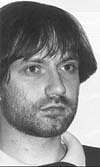
Claus-Steffen Mahnkopf offered Angelus Novus in conjunction
with a collaborator Taygun Nowbary, who provided (completely independently)
visual images, including Walter Benjamin texts, on three large screens placed
behind staged events with two mime actors. Mahnkopf, based in Freiburg, is
a prominent academic and co-producer of the journal Music &
Aesthetic. He conducted a seminar at Munich during the Bienniale with
Carl Andre, of whom more below, and the concert now to be discussed below
was organised as a part of that exercise. Mahnkopf's music for Angelus
Novus consisted of six segments, 3 instrumental soli and three ensemble
pieces, the largest of those Angela Nova for wordless soprano, Monika
Meier-Schmid, who conveyed basic mind states of fear, happiness, hope,
grief and despair. A Second Chamber Symphony was 'devoted to what faces humanity:
civilisation' and allegedly confronts the politics of the 20th Century. The
third ensemble piece Solitude-Serenade, on the theme of loneliness, had been
developed from an earlier composition for oboe, Solitude Nocturne and was
to offer us 'a glimpse into the 21st Century'.
To make all even more unclear, those 6 works (each of which can be performed separately and, of course, apart from the visual accompaniments) were themselves sliced into segments. Those were intercut with one another during the 85 minute uninterrupted playing of Angelus Novus, linked by 'noise music' played by percussionist Olaf Tzschoppe. The whole event was directed by James Avery and the music played by the admirable Ensemble SurPlus, with soloists who were deployed around the Muffathalle, a useful auditorium in a converted industrial building by the racing river. The solo flautist, Carin Levine, was placed high up in the roof!
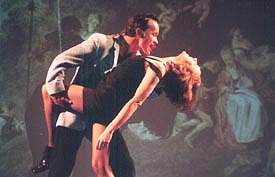
In front of the screens, the Man & Woman (Robert Spitz & Ruth
Geiersberger) performed on a sloping ramp stage. As Adam and Eve they explored
the Apple and endeavoured to come to terms with Death. Later they demonstrated
wish fulfilling erotic fantasy, opposed to a more likely reality, in a scene
of courtship ritual in an art gallery. They also were involved in trying
to repair the World Globe, which repeatedly slipped down the slope and was
brought back into precarious equilibrium in the nick of time. The benign
'World mechanic' came to the
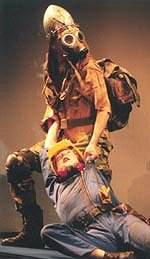 assistance
of a sinister, gas-masked and mutilated war victim, only to be strangled
for his trouble! A flame advanced towards the globe along a fuse, and the
piece ended with darkness just before the feared explosion. These activities
were absorbing and made an interesting counterpoint, though inevitably detracting
from full attention to the music. The screened pictures and texts were less
interesting, over reliant on very familiar images and film clips.
assistance
of a sinister, gas-masked and mutilated war victim, only to be strangled
for his trouble! A flame advanced towards the globe along a fuse, and the
piece ended with darkness just before the feared explosion. These activities
were absorbing and made an interesting counterpoint, though inevitably detracting
from full attention to the music. The screened pictures and texts were less
interesting, over reliant on very familiar images and film clips.
The music itself finally left only a generalised impression; using a lot of extended instrumental sounds, it was probably fully notated, but athematic,. Most striking were the vocal sections, a development of techniques developed by Berio for Cathy Berberian, and Ligeti in his Aventures, well projected by Monika Meier-Schmid. The whole, as was the case too with Chernovin's Pnima…Inner States, seemed disproportionate in its complexity and unlikely to achieve a future theatrical life outside specialised contemporary arts festivals.
It would be good to hear the Mahnkopf's music for Angelus Novus in more straightforward circumstances. The ideal would be a CD of the six pieces, with indexed tracks enabling them to be played straight through individually or, by the listener's choice, as sliced and collaged in Angelus Novus. Meanwhile, Mahnkopf's earlier music can be sampled on a CD which includes the oboe piece Solitude-Nocturne [Baldreit-Edition, Baden-Baden 1995 - Csmahnkopf@t-online.de].
Concerts
Small can be best! Having been disappointed with two elaborate music theatre productions, a small scale concert given by members of Ensemble SurPlus brought considerable satisfaction. It was good to hear again in Germany Roger Redgate's Esperons for oboe and a small jazz set (Peter Veale, oboe with Olaf Tzchoppe, percussion), an exploration of the interactions between free jazz improvisation and rigorous notation of complex music on the edge of playability. It arose from reading Derrida and reflecting on the work of Braxton, Parker and Oxley, and considering what can and what cannot be notated.
New to UK listeners were three solo works for piano, viola and percussion. Bernd Asmus took as his starting point for Knell the poetic idea of developing a sound world in a dark room and looking for a way to get to the light. It began with clear, readily intelligible figurations in the lower register, with a build up of resonance inside the piano. A mid-register melody sought to form above it and the climax was 'a stream of lava' in complex polyphony, with 'death bells'. A very striking piece, which would grace any contemporary piano recital, played from memory convincingly by Sven Thomas Kiebler. Wolfram Schurig explained that the genesis of his CRWTH for solo viola (Dimitrios Polisoidis) was the many sounds made on the string, how they are produced, what are their potentialities. He said it was important for him (and for us) to listen to these sounds without preconceived ideas. By doing so he was able to integrate a wealth of extended techniques into a continuous composition, which also incorporated, in a completely natural way, snatches of conventional virtuoso techniques, which made for a link with other solo string music from the past. It was grateful music, going with the viola and its nature, not against it. A rewarding work for an open minded UK violist to consider programming?
Marc André's Un-fini III need not detain us. His overlong and abstract theoretical introduction left us waiting for proof of the theory in the music itself. It too proved to be overlong, unoriginal and reliant on conventional figurations, with many arpeggios and trills. On the other hand Di-remption by Frank Cox for solo percussion (Jonas Larsson) was a piece of real music for percussion, not a vehicle for display for its own sake. It was expressive and compelling in performance, with the 'notes' and elements of melody, even though it was all played on untuned instruments, congas, bongos, tom toms and snare drum. The underlying concept was a battle for identity amongst the different drums. The clamour for supremacy builds up resistances until finally they cancel each other out and merge into a complex unity. One drum can't quite manage to assimilate itself and remains the odd one out, repeatedly missing the main beat. The unitary identity can't hold, and at the end the music falls to pieces. This is a piece which would appeal to an 'intellectual' percussionist, like Pedro Carneiro from Portugal.
Our last concert, in the very pleasant Bayerische Rundfunks Studio 2 (set out informally with chairs around tables) was a mixture of new and old avant-garde given by the Ensemble Triolog, whose line up of wind, strings piano and percussion included British violinist Peter Sheppard Skaerved, whose solo violin recital [Metier CD 92028] has recently been reviewed in MotW. For Xenakis' duo Charisma (1971) clarinet and cello were place far apart across the stage and the piece emphasised contrasts in modes of playing, seemingly independent of each other. Isang Yun (1917-95) was one of the earlier composers to investigate the rich seam of cross-over between his Korean origins and later espousal of Western new music in Darmstadt, and I have long treasured an LP of his music. His 1973 Trio for flutes, oboe and violin explored microtonal shifts in long sustained notes and the 'difference tones' which emerged from close, high notes sounded together - a disturbing effect, which was a feature of several pieces in this concert. Scelsi's Rucke di Guck (1957) is a high spirited nine minute caprice in three substantial movements for piccolo and oboe, perhaps the major recent serious work for the former instrument, given with zestful exuberance by Burkhard Jackle and Stefan Schili. It is included in a delightful CD of Scelsi chamber works with flutes featuring two of the artists heard in Munich, Carine Levine (flutes) and Peter Veale (oboe) - CPO 999 340-2.
Of composers less known in UK, the most senior was Josef Anton Riedl (b. 1927), whose recent piece for piano (Jan Philip Schulze) and percussion (Stefan Blum) needed close ensemble and had interludes of very complex clapping by both musicians. Martin Smolka (b 1959) had some very strident Autumn Thoughts for flute, clarinet, violin & cello, piano & percussion, requiring the players to augment fast, screeching music with mouth organs played at the same time. He finished with a procession of long slow notes. Tobias Schneid (b. 1963) conducted the premiere of his new piece, whose greatest originality was perhaps its title, umbrellas & sewing machines'- music for a man who was cut into pieces by a window! Though by no means minimalist, it gave us the rare pleasure in this company of consonant harmony, absent from most of the concert, together with colourful percussion sounds; the oboe and clarinet were required to modify their notes with the aid of pedal-timpani.
The most interesting novelty by far was Hanspeter Kyburz's 1997 Danse aveugle, which wove a complex tapestry of crowded events from the varied repetitions of 40 small fragments. This lengthy piece for quintet (fl, cl, vln, vcl & piano) was conducted by Triolog's percussionist, Stefan Blum, and confirmed my impression that this 40-yr old composition professor at Berlin, recently introduced to London is one whose music deserves seeking out .
There are two recommendable Kyburz CDs, each including his Cells for saxophones and large chamber orchestra, which had been played in the London Sinfonietta concert at South Bank (see S&H review). In the Swiss Grammont Portrait Series Cells can be heard with Parts and The Voynich Cipher Manuscript for 24 singers and ensemble MGB CTS-M52, and on col legno 31890 it is combined with works involving saxophones by Staude, Mundry and Zimmermann. Both are desirable and performances, recording and presentation are equally good.
Late night piano recital
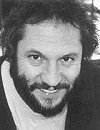
Siegfried Mauser attracted an audience of 100 to his late night piano
recital in the Black Box studio auditorium at the Gesteig. His one-hour
programme, played without applause between items at his request, was a uniquely
selected conspectus of radical writing for the instrument from 1883 to 1988.
The emphasis was on the brutalism of extreme dynamics and spare textures,
with Feldman's particular pianissimo austerity as a foil to the other louder
music. Liszt's late piano pieces sit comfortably in avant-garde company,
and Mauser began with Unstern, Sinistre-Disastro, light years away
from the flamboyant pianistic display of typical Liszt. The biggest surprise
for many of us would have been Arvo Part's Partita Op. 2 (1958). This was
uncompromising, severe contrapuntal music, much of it very loud and dry -
an important demonstration of where the future change to Holy Simplicity
had come from, and a piece that would please many for whom Part's later style
is antipathetic.
Galina Ustvolskaya fitted naturally into these surroundings and we heard lucid, forthright accounts of her two last sonatas (1986/88). The fifth was followed by Palais de Mari, one of Feldman's shorter pieces, a mere twenty minutes or so of sustained pianissimo. Feldman's deceptively simple chords proved a welcome antidote to the barrage preceding it, focussing attention upon subtle, written in rhythmic uncertainties, the voicing of the individual chords, and the decay of piano tone between them. After that, the tumultuous final Sonata No. 6 of Ustvolskaya, a torrent of clusters played fff and ffff with hands and forearms, sounded positively indecent, and can never have made so powerful an impression as in this context. A well planned concert, received near midnight with unbounded enthusiasm.
[Ustvolskaya's piano music on CD is surveyed by PGW on Music on the Web's section on Composers from Other Countries]
Paradisi Gloria (concert of 20 C. religious music)
The Munich Radio Orchestra of Bayerischer Rundfunk gave a concert at St Gabriel's Church, which proved to be a strange and illuminating event. Kancheli's Nachtgebete had been, at the suggestion of Menfred Eicher of ECM, expanded for soprano sax, tape and string orchestra from an earlier score for the Kronos Quartet. It inhabits a similar world to the collaborations between Jan Garbarek (soprano saxophone) and the Hilliard Ensemble (appearing later in the Biennale) which have proved runaway successes for ECM. Mostly it relied on smooth and simple accompaniments for the extended sax melodies. We awaited Kancheli's characteristic explosive shocks, but all that happened was that the texture was 'roughed up' a little a couple of times. Not an earth shaking new version.
It was followed by two early works of Messiaen. The faster sections of Le tombeau resplendissant (1931), which must have earned him a reputation as an enfant terrible at the time, were an unmitigated disaster in the resonant church acoustic, coming across as scrambled cacophony! The slow final section, though, sounded well; a very beautiful extended melody for cellos, which anticipated Messiaen's later music in that vein. Seeing a dozen microphones below a specially erected canopy, I shall be intrigued to find how it sounds in the forthcoming broadcast.
It was a gratifying surprise to discover that within a few years Messiaen himself had solved the familiar problems posed by orchestras in churches, thrown up so starkly on this occasion. His four meditations of 1931 L'ascension, known from broadcasts and concert hall performances in the Royal Festival Hall, have never been a favourite of mine, the final prayer extremement lent often seeming less than elevating and interminable. Here, under the orchestra's regular director Marcello Viotti, it all proved to have been perfectly judged and conceived for a church acoustic and was very moving, whether the chorale-like passages for brass or the final ascent to Heaven by higher and higher strings, with the double basses silent. Rarely has one been confronted with the acoustic of the venue as being so central to the conception and experience of music and its performance. A worthwhile experience; L'ascension is a work which would go well at the Albert Hall, or in our notorious St Paul's Cathedral, which has similar acoustical problems.
For readers whose appetite may have been whetted by S&H's coverage of continental festivals for broadcast music beyond the BBC R3 diet I can recommend the acquisition of digital satellite radio. The Munich Radio Orchestra's Paradisi Gloria concert of Kancheli & Messiaen can be heard 22 May at 21.05 (UK time) on Bayern 4 Klassik.
The same radio station will broadcast live the final piano jamboree of the Biennale, piano music for four to twelve hands by Reger, Debussy, Messiaen, Zimmerman, Henze, Guinjoan, Ravel, Riedl, Stravinsky, Bartok, Crumb, Killmayer, Lutoslawski, Milhaud, Satie, Feldman, Rihm, Eggert, Kurtag and finishing with Reich's Six Pianos; 19 May 19.05 until 1.05 early Saturday morning (UK time)! There is a whole different music world out there, and Seen&Heard will continue to endeavour to bring you reports from distant places.
Peter & Alexa Woolf
 Return to:
Return to: